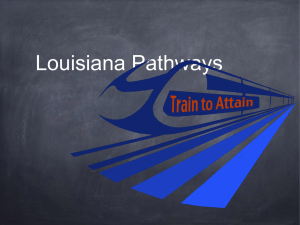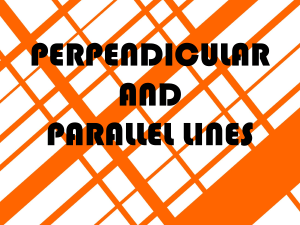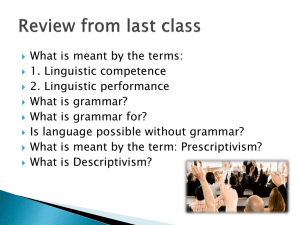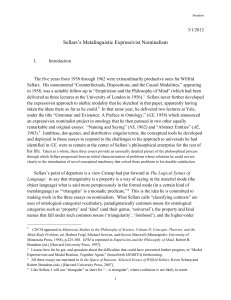Notes on "Abstract Entities"
advertisement
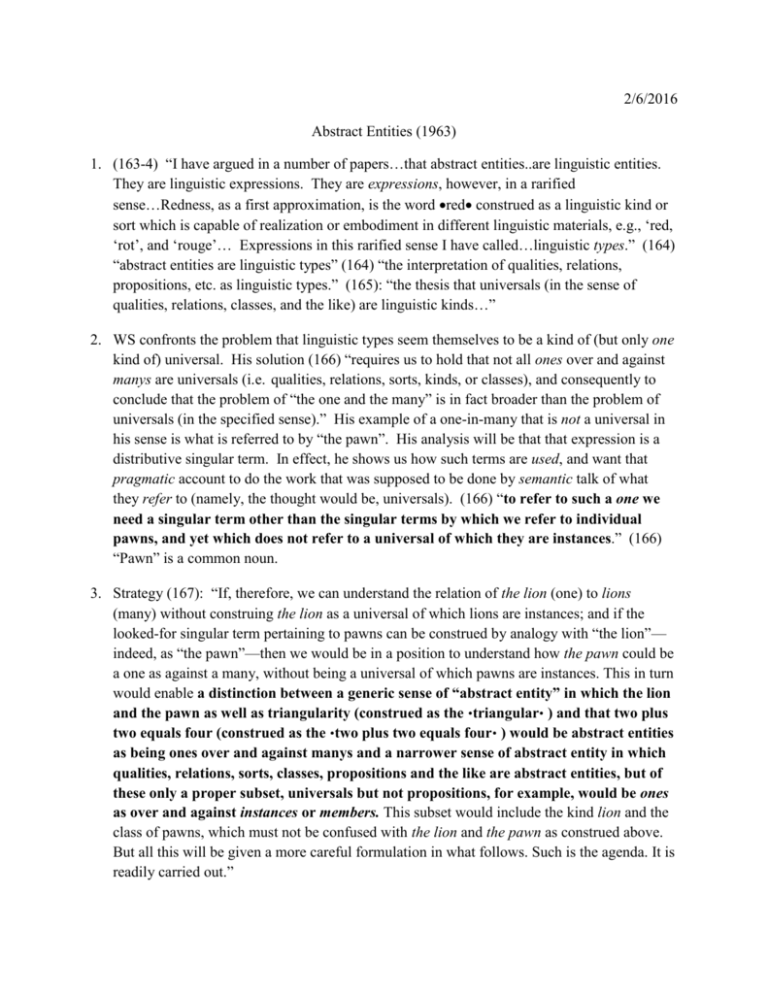
2/6/2016
Abstract Entities (1963)
1. (163-4) “I have argued in a number of papers…that abstract entities..are linguistic entities.
They are linguistic expressions. They are expressions, however, in a rarified
sense…Redness, as a first approximation, is the word red construed as a linguistic kind or
sort which is capable of realization or embodiment in different linguistic materials, e.g., ‘red,
‘rot’, and ‘rouge’… Expressions in this rarified sense I have called…linguistic types.” (164)
“abstract entities are linguistic types” (164) “the interpretation of qualities, relations,
propositions, etc. as linguistic types.” (165): “the thesis that universals (in the sense of
qualities, relations, classes, and the like) are linguistic kinds…”
2. WS confronts the problem that linguistic types seem themselves to be a kind of (but only one
kind of) universal. His solution (166) “requires us to hold that not all ones over and against
manys are universals (i.e. qualities, relations, sorts, kinds, or classes), and consequently to
conclude that the problem of “the one and the many” is in fact broader than the problem of
universals (in the specified sense).” His example of a one-in-many that is not a universal in
his sense is what is referred to by “the pawn”. His analysis will be that that expression is a
distributive singular term. In effect, he shows us how such terms are used, and want that
pragmatic account to do the work that was supposed to be done by semantic talk of what
they refer to (namely, the thought would be, universals). (166) “to refer to such a one we
need a singular term other than the singular terms by which we refer to individual
pawns, and yet which does not refer to a universal of which they are instances.” (166)
“Pawn” is a common noun.
3. Strategy (167): “If, therefore, we can understand the relation of the lion (one) to lions
(many) without construing the lion as a universal of which lions are instances; and if the
looked-for singular term pertaining to pawns can be construed by analogy with “the lion”—
indeed, as “the pawn”—then we would be in a position to understand how the pawn could be
a one as against a many, without being a universal of which pawns are instances. This in turn
would enable a distinction between a generic sense of “abstract entity” in which the lion
and the pawn as well as triangularity (construed as the triangular ) and that two plus
two equals four (construed as the two plus two equals four ) would be abstract entities
as being ones over and against manys and a narrower sense of abstract entity in which
qualities, relations, sorts, classes, propositions and the like are abstract entities, but of
these only a proper subset, universals but not propositions, for example, would be ones
as over and against instances or members. This subset would include the kind lion and the
class of pawns, which must not be confused with the lion and the pawn as construed above.
But all this will be given a more careful formulation in what follows. Such is the agenda. It is
readily carried out.”
4. [T]he fundamental theme is the equivalence schema
The K is f All Ks are f†
where this represents an identity of sense, the dagger indicating that the righthand side is a
“non-accidental” truth about Ks (i.e., [roughly] that being f is either one of the criteria for
being a K or is implied by the latter on inductive grounds. [167]
5. (168) “Now if we reflect on the two statement forms
1. The K is a one
2. Ks are a many
we note that they are in the material mode, the former having (in first approximation) the
sense of
“The K” (in English, our language) is a singular term,
the latter (and it will be noticed that the plural verb is an unperspicuous consequence of
surface grammar) having the sense of
“Ks” (in English, our language) is a plural term.” BB: Compare this move to the “syntactic
strategy” of “Grammar and Existence” (GE): they are understood as “material mode”
“equivalents” of “formal mode” claims. I have suggested that the sense of “equivalence”,
which WS struggles to express, is best understood in terms of the pragmatically mediated
semantic relations of BSD. Again, “the K” is in this sense a nominalization of the common
noun = sortal predicate ‘K’. (Really, K--Quinean corner quotes.)
6. (168) “I propose to call expressions of which “the lion” is a paradigm example “distributive
singulars.”
7. (169) “To construe “triangularity” as having, albeit less perspicuously, the sense of “the
triangular”…” Notice that here WS talks of “sense”, where in GE he talked of “force”. In
general he is not clear about the relations he envisages between what he is explicating and
what it is explicated in terms of.
8. Thus, “triangular” would be the common name of items which play the role played in our
language by *triangular*s, where the asterisk quotes form the common name of the design
tokens of which one is found between them. [169]
9. (169) “In the use which we have in mind, neither “the pawn” nor “the lion” is the name
of the role or kind to which the common noun pertains.”
10. (170) “Both the idea that qualities, relations, kinds, and classes are not reducible to
manys and the idea that they are reducible to their instances or members are guilty of
something analogous to the naturalistic fallacy.”
11. (170-1) “the corresponding equivalences pertaining to pieces in a rule-governed system…”
“the criteria have been split into a descriptive and a prescriptive component. It is the latter
which is essential to the character of the equivalence as defining a “piece”…The division of
the criteria into descriptive and prescriptive components is, potentially, the drawing of a
distinction between a “piece” in a narrower sense (the criteria of which are specified by the
prescriptive component) and what might be called a recognized “embodiment” or
“materialization” of the piece.”
12. Texas chess (172).
13. (173) “the conception of our language as one way of playing a game with more generic
descriptive criteria of which there are other mutually different varieties is already implicit in
the conceptual framework we actually use.”
14. (173) “I have been proposing (as a first approximation) a “rational reconstruction” of
triangularity as the triangular
15. (176) “”within the limited horizon, the abstract suffix “-ity” can be regarded as a form of
quotation, thus triangularity and “triangular” would be parallel constructs.
16. [W]e can always take an adjective and form a singular term from it by the use of an
appropriate suffix, the result is often stilted and artificial, and competes with a standard
expression involving such a suffix, but of which the stem is no longer an adjective in actual
use. [177]
17. (176)-(179) are on various forms of quotation, leading up to his “contrived linguistic role or
office common nouns”, such as triangular. (179): “If we bear in mind our earlier
discussion of the criteria for application of common nouns, we can say that dot quotation
corresponds to ordinary quotation where the latter practice has been modified in such a
way that the descriptive component of the criteria for the application of the common
noun formed by quoting has been reduced to that which is implied by the prescriptive
component, and the latter has been given its most generic formulation.” [Ftnt 13 here
says WS will not argue, but does believe, that these roles can be specified in terms of
language-language, language-entry, and language-exit moves.] This account of quotation,
and in particular the account of the relation between “”, , and ** (asterisk quotes, which
name sign-design types, where “” names words), should be read in connection with
McDowell’s “On Quotation and Saying That”. (Cf. McD’s observation that mentioning a
word is a kind of use of it.)
18. (179) Let us, therefore, continue to use expressions formed by means of dot quotes to refer
to linguistic types, which latter, though identifiable (by virtue of the name-forming practice)
as the types realized in our language by the designs within the quotes, do not have being of
these designs among their criteria. Thus, a triangular need not be a *triangular* (written or
spoken). It can be a *dreieckig*. The most useful way to put this at the present stage of the
argument is by the proportion
expression formed by
dot quotes
——————————
expression formed by
ordinary quotes
=
“pawn” as applying to the appropriate pieces
in any game which can be regarded as a
different embodiment of chess
————————————————————
“pawn” as applying to the familiarly shaped
pieces used in ordinary chess
19. On nominalization and dot-quotes: “[W]whereas ordinary quotation forms an expression
which, depending on context, functions as a common noun or as the corresponding singular
term, we shall give our dot quotes the job of forming an expression which must be preceded
by “the” to form the corresponding singular term. [179]
20. (179): “Triangularity = the triangular That it is raining = the it is raining”
21. (180) on immediate vs. ultimate criteria of application of dot-quoted expressions.
22. Section IV (there is no Section III) is an aside, explaining in terms of dot-quotes how (a)
Triangularity is a universal and (b) Triangularity is an individual, can both be true. Ftnt 17
(183) has the interesting remark that: “Although it is philosophically illuminating [BB: But
need this possibility be understood as entailing nominalism?] to reconstruct such material
mode of speech categories as ‘individual’, ‘quality’, ‘relation’, etc. as classifications of
linguistic types, ordinary discourse does not provide for a reduction of statements involving
them which would parallel the straightforward reduction of their formal mode of speech
counterparts.” Here the last notion of “formal mode of speech counterparts” is the best WS
can do to describe the relation he is interested in. BSD vocabulary is more flexible, and will
render it better—without, I think, the ontological-semantic consequences WS draws from the
possibility of such counterparts. For he is really saying what we must be able to do in order
to deploy ‘triangularity’ (‘property’, ‘universal’, etc.), namely be able to deploy ‘…is
triangular’. This is a PP-necessity and PP-sufficiency claim regarding practices-or-abilities
that are PV-sufficient to deploy those expressions. I do not yet have a clear sense of what
conclusions one should draw from these facts about semantic metavocabularies for those
expressions.
23. The possibility that the word “kind” might have these two senses throws light on Russell’s
erstwhile distinction between classes as ones and classes as manys. Or, with an eye to Frege,
we can say that in contexts such as (g) kinds are distributive objects, whereas in (f)-like
contexts they are concepts or functions. [186]
24. Section VI lets us “see more clearly why it is incorrect to say that all abstract individuals are
linguistic, where “abstract individual” is given the sense of “distributive individual.” The
reason is that (187): “— is a linguistic abstract (distributive) individual
becomes
—s are metalinguistic distributive singular terms,
and appropriate examples of these forms would be
The triangular is a linguistic abstract (distributive) individual
the triangulars are metalinguistic DSTs.
Thus, since it is not true that
the lions are metalinguistic DSTs
it is not true that
The lion is a linguistic distributive individual.”
Section V sets up this discussion, by considering the “formal mode counterparts” of various
material mode claims, and then regimenting them using common nouns and DSTs formed by
dot-quotes.
25. Section VII explains that on this account there are abstract entities that are not objects, but
functions (188-9):
“1.
The lion is a (distributive) individual and not a kind (i.e., The the lion is a DST and not
a common noun.
2.
Lionkind is a kind and not a (distributive) individual (i.e., The lion is a common noun
and not a DST).
3.
Lionkind is a (distributive) individual and not a kind (i.e., The the lion is a DST and
not a common noun).
4.
Triangularity is a quality and not a (distributive) individual (i.e., The triangular is a
predicate and not a DST).
5.
Triangularity is a (distributive) individual and not a quality (i.e., The the triangular is
a DST and not a predicate).
In (1), (3), and (5), we have examples of items which are objects and not functions; in (2) and
(4), examples of items which are functions and not objects.”
This raises the question (189): “What, then…is the formal mode counterpart of “abstract
entity”?” The answer offered is the disappointingly evasive (190): “This points toward an
interpretation of “entity” rather than “abstract entity” as the material mode for “linguistic
expression,” and to a distinction between “non-abstract” and “abstract” entities which
reflects a basic dichotomy between kinds of linguistic expression. Just how this latter might
be characterized (or, indeed, whether a simple dichotomy will do) falls outside the scope of this
paper.” He goes on to suggest that wider and narrower senses are available, with the narrower
sense corresponding to metalinguistic expressions such as “the triangular”, rather than “the
lion”.
26. Although he has been careful about the issue in the previous section, WS begins section VIII
with a Fregean howler (192): “Frege’s concepts are a subset of senses—predicative senses.”
27. Section IX (192) begins: “We must now make good a still more basic oversimplification in
our rational reconstruction of such abstract singular terms as “triangularity” as the names of
linguistic types which are typically embodied in our language by the designs of which they
contain an illustration (i.e., as having the force, in terms of our quoting convention, of, for
example, “the triangular”). For, while these abstract singular terms are names of linguistic
types, and, indeed, of types to which the designs they illustrate are intimately related, it is at
least an oversimplification to say that the types in question are realized in these designs.”
28. The closing section, IX, is concerned with how one might generalize what WS calls “the
illustrating sign design principle” ((195), (196)) employed by dot quotes for languages that
are sperspicuouss (with respect to Bradley’s problem), such as Jumblese. This is, as he notes
(199), a matter of metalanguages for Jumblese, and (worse) Jumblese metalanguages. An
interesting project would be to do better what WS does here: say how to form dot-quoted
expressions and their corresponding (by adding ‘the’) DSTs, for and in Jumblese. Thus
(199): “The question, “What Jumblese expression, if any, stands for triangularity?” as
interpreted in the preceding paragraph must not be confused with the question What
Jumblese expression, if any would be the translation of “triangularity”? The latter, of course,
would presuppose an account of Jumblese metalanguages, a difficult but by no means
impossible task which will not be attempted here.” In general, WS is here trying to clarify
the job being done by the illustrating sign design principle by exploring the extent to which
that same job (role, office) could be done in some other way. (Along the way he is
concerned (198) to distinguish metalinguistic variables from metalinguistic constants which
name object language variables, in his own formulations.) The discussion is tedious, but
careful.
29. Conclusion of this discussion of Jumblese (200-1): “ [I]t can be suggested that the
Jumblese counterpart of
The triangular INDCON
(which is our PMese type rational reconstruction of “triangularity”) might well be “INDCON”
where the illustrating principle is followed by forming this metalinguistic expression in the same
style as is used in the object language to say of something that it is triangular. Thus, assuming
that Jumblese uses our quoting convention, we would have the following counterparts
Illustrating
Illustrating
Jumblese ML
PMese ML
That a is triangular
a
the triangular (a)
Triangularity
That something is triangular
INDCON
the triangular INDCON
{
Brandom
To return to the primary line of thought, I conclude that triangularity is not to be
construed as the triangular, but rather as being the type realized in the PMese dialect of our
language by expressions formed by concatenating a *triangular* with an individual constant—
and in PMese dialects of subject-predicate languages generally by bringing into an appropriate
relation (e.g., concatenating) a triangular and an individual constant.”
30. More (201): “From this point of view, the classical problem of universals rests in large part
on the fact that, in such languages as English and German expressions referring to universals
are constructed on an illustrating principle which highlights a design which actually plays a
subordinate role, and consequently tempts us to cut up such sentences as
Triangular (a)
into two parts, one of which has to do with the universal rather than the particular, the other
with the particular rather than the universal, and tempts us, therefore, to construe the
statement as asserting a dyadic relation (“exemplification”) to obtain between the particular
and the universal.”
31. Conclusion, reverts to the discussion at the end of NS, on the relation between
exemplification and truth, and the connection of the latter to a kind of doing. (202-3): “Thus
the “relation” of exemplification which for Platonists binds the realm of becoming to the
realm of being, and which for more moderate realists binds the “real” order to the “logical”
or “conceptual” order, is an offshoot of the “relation” of truth, which analysis shows to be no
relation at all, but a sign of something to be done.” What is to be done, we were told in NS,
and the point is reiterated here, is making inferences (203). He further refers to the
normative character of claims about necessary relations among universals (“Triangularity
implies trilaterality,”) and it is again clear that he means what inferences it is (would be)
correct to draw.
32. Modal, intentional, normative, ontological-categorial
2


